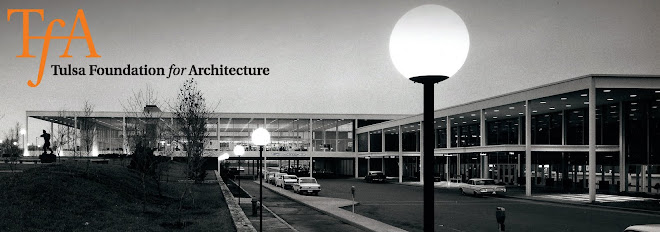
Friday, October 23, 2009
Sixth Annual Foundation Awards

Thursday, June 25, 2009
Third Annual Downtown Living Tour

Friday, June 5, 2009
Living in HiFi: Lortondale Home Tour

"Living in HiFi" will be an annual modern home tour hosted by the Modern Tulsa committee of the Tulsa Foundation for Architecture. Focused on mid-century modern residential architecture, the tour will seek to promote an awareness and the preservation of this oft-overlooked and dismissed style of architecture.
"Living in HiFi" will premiere June 13th in the historic Lortondale Neighborhood.
Designed and built in 1954 by Tulsa duo Donald Honn (architect) and Howard Grubb (builder), the Lortondale Neighborhood was the recipient of a multitude of national design awards. The neighborhood was featured in an array of magazines including House and Home and Better Homes and Gardens.
In recent years Lortondale has experienced something of a rebirth. A new generation of homeowners, interested in modern design, are snapping up the houses just as fast as they come on the market. After decades of neglect, many of the houses in the neighborhood are being restored to their former modern glory. Most importantly, the Lortondale Community is experiencing the same restoration.
This year's tour seeks to convey the energy that is the Lortondale Neighborhood today. Featured are 6 houses in various stages of completion. From the beginning stages of a restoration to a virtually complete example of HiFi-modern bliss, this tour of Lortondale will show you what all the buzz is about.
Tickets are $10 in advance and $15 day-of. The tour will take place from 5:30 - 8:30 with an after party lasting from 8:30 -?
Tickets are available for purchase at the following locations:
Dwelling Spaces
119 South Detroit
Urban Furnishings
3636 South Peoria
Ida Red
3346 South Peoria
TFA Architectural Archives
321 South Boston, Suite #LL01
Wednesday, April 29, 2009
Old City Hall Update
Wednesday, April 8, 2009
Meadow Gold Sign
Monday, March 9, 2009
Oklahoma's Endangered Places
Tuesday, March 3, 2009
Old City Hall
Whether you like the building(s) or not, they are a part of Tulsa's architectural history and we would lose a significant piece of history if the building is demolished, not to mention the enormous amount of material that would go straight to a landfill. I had a professor in grad school that was constantly reminding us that 'history isn't always pretty' and I think that is applicable in this situation (not that I'm saying Old City Hall isn't pretty, but I know most people don't think so). I hope that people will recognize the cultural significance of the Old City Hall and realize how shortsighted it would be to demolish such an important piece of Tulsa's architectural history just because some people don't like the way it looks. Sure some may think it's 'ugly' now, but there was also a time when people hated Art Deco; I know some may have a hard time believing it, but it's true. By the time people started realizing how important the Deco buildings from the '20s and '30s were, almost half had already been demolished. Thankfully, people stopped before all of our deco buildings were gone. I really hope that we don't have to demolish half of Tulsa's iconic mid-century buildings before we realize how important they are.
Friday, February 27, 2009
Jones House
In addition to being featured in A & A, the German publications of Bauen + Wohnen (Jan. 1961) and Schoner Wohnen (Sept. 1963) also featured the 2800 square foot house. According to the Tulsa Preservation Commission, the Jones House was the first International Style residence built in Oklahoma (anyone know of the second?), which makes sense because Jones studied under Mies van der Rohe while attending graduate school at the Illinois Institute of Technology. The TPC also states that other than Goff's Bavinger House, the Jones House is the most recognized Oklahoma residence built in the last 50 years. Personally, I much prefer the Jones House. The house's listing in the National Register of Historic Places confirms the house's importance in a few ways. First, the house's listing is not part of a historic district, but is individually listed. Secondly, the house was listed in 2001 when it was only 42 years old. This is significant because generally, properties less than 50 years are not considered eligible for listing in the register. There are a few exceptions, one of them being, "a property achieving significance within the past 50 years if it is of exceptional importance" (from the SHPO's NR criteria). So there you have it, the Jones House is of exceptional importance. Here are some of the scanned pages from the various magazines.

Wednesday, February 18, 2009
Kershner Vacation House


If anyone has any more information on this very cool house, leave a comment or send me an email, derek@tulsaarchitecture.com
Friday, February 13, 2009
Arts & Architecture
Tuesday, February 10, 2009
Catching Up




Thursday, February 5, 2009
Hey! We've got a blog!
derek.











